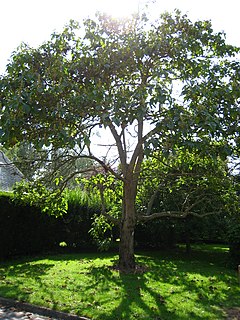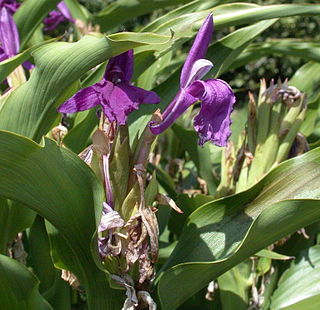
Paulownia is a genus of seven to 17 species of hardwood tree of C4 flowering plants in the family Paulowniaceae, in the order Lamiales. They are present in much of China, south to northern Laos and Vietnam and are long cultivated elsewhere in eastern Asia, notably in Japan and Korea where they are native.

Calyceraceae is a plant family in the order Asterales. The natural distribution of the about sixty species belonging to this family is restricted to the southern half of South-America. The species of the family resemble both the family Asteraceae and the Dipsacaceae.
Cordylanthus capitatus, the Yakima bird's-beak or clustered bird's-beak, is an uncommon plant of the Western U.S.
This page provides a glossary of plant morphology. Botanists and other biologists who study plant morphology use a number of different terms to classify and identify plant organs and parts that can be observed using no more than a handheld magnifying lens. This page provides help in understanding the numerous other pages describing plants by their various taxa. The accompanying page—Plant morphology—provides an overview of the science of the external form of plants. There is also an alphabetical list: Glossary of botanical terms. In contrast, this page deals with botanical terms in a systematic manner, with some illustrations, and organized by plant anatomy and function in plant physiology.

Cuscuta europaea, the greater dodder or European dodder, is a parasitic plant native to Europe, which belongs to the family Convolvulaceae, but was formerly classified in the family Cuscutaceae. It grows on Asteraceae, Cannabaceae, Chenopodiaceae, Fabaceae, Urticaceae and other herbaceous plants, including garden plants such as Coleus and Impatiens. It is a notable parasite of lucerne. In many regions, including the Nepal Eastern Himalayas, this species are used as traditional medicine to treat hepatic diseases.
Plectocomiopsis is a dioecious genus of flowering plant in the palm family found in Indochina, Malaysia, Borneo and Sumatra. Hapaxanthic and armed with spines, they are a climbing rattan, closely related to the Myrialepis palms. The name is Greek for "similar to Plectocomia", another close relative.
Pogonotium was a dioecious genus of flowering plant in the palm family found in Malaysia and Borneo. Its species are now included within the genus Calamus. Its close relatives are climbing rattans and while partially armed with climbing apparatus, its habit is sprawling and leaning but not effective climbing. The reduced inflorescence nestled between the auricles is unusual and distinguishes it from similar relatives like Calamus, Daemonorops and Ceratolobus. The name is Greek meaning "bearded".
Retispatha is a rare, monotypic genus of flowering plant in the palm family endemic to Borneo, where the sole species, Retispatha dumetosa, is known as wi tebu bruang or 'the bear's sugar cane'. The name combines Latin and Greek words meaning 'network' and 'spathe', and the species epithet means 'bushy'. While classified with other rattans, they retain only superficial climbing organs; they sprawl and lean but are not true climbers.

Florissantia is an extinct genus of flowering plants in the Malvaceae subfamily Sterculioideae known from western North America and far eastern Asia. Flower, fruit, and pollen compression fossils have been found in formations ranging between the Early Eocene through to the Early Oligocene periods. The type species is Florissantia speirii and three additional species are known, Florissantia ashwillii, Florissantia quilchenensis, and Florissantia sikhote-alinensis.

Brunfelsia pauciflora is a species of flowering plant in the family Solanaceae, the nightshades. It is endemic to Brazil, and it is grown in cultivation. A shrubby perennial plant grown in gardens, its common names include yesterday-today-and-tomorrow, morning-noon-and-night, kiss me quick, and Brazil raintree.
This glossary of botanical terms is a list of definitions of terms and concepts relevant to botany and plants in general. Terms of plant morphology are included here as well as at the more specific Glossary of plant morphology and Glossary of leaf morphology. For other related terms, see Glossary of phytopathology and List of Latin and Greek words commonly used in systematic names.

Roscoea auriculata is a perennial herbaceous plant occurring in the eastern Himalayas, in Tibet, Bhutan, Nepal and Sikkim. Most members of the ginger family (Zingiberaceae), to which it belongs, are tropical, but R. auriculata, like other species of Roscoea, grows in much colder mountainous regions. It is sometimes grown as an ornamental plant in gardens.

Roscoea alpina is a perennial herbaceous plant native to the Himalayas. Most members of the ginger family (Zingiberaceae), to which it belongs, are tropical, but R. alpina, like other species of Roscoea, grows in much colder mountainous regions. It is sometimes grown as an ornamental plant in gardens.

Roscoea capitata is a perennial herbaceous plant native to the Himalayas, being found in Nepal. Most members of the ginger family (Zingiberaceae), to which it belongs, are tropical, but R. capitata, like other species of Roscoea, grows in much colder mountainous regions.
Roscoea ngainoi is a perennial herbaceous plant occurring in the Ukhrul district of Manipur state, India. Most members of the ginger family (Zingiberaceae), to which it belongs, are tropical, but like other species of Roscoea, R. ngainoi grows in much colder mountainous regions.

Monopsis is a genus of small, Lobelia-like herbaceous plants indigenous to Africa. A few species are annuals, but most are perennials. Common names are not well established, but often refer to more familiar plants, as in "wild violet" for Monopsis unidentata, "yellow lobelia" for Monopsis lutea or "pansy lobelia" for Monopsis debilis.

Reyesia is a small genus of four species of flowering plants belonging to the subfamily Cestroideae of the nightshade family Solanaceae. It is closely related to the genus Salpiglossis, which provides the ornamental species Salpiglossis sinuata. Together, the genera Reyesia and Salpiglossis form the tribe Salpiglossideae within the Cestroideae. Historically, the species now placed in Reyesia have been held by some authors to belong to Salpiglossis, but are currently placed in a genus of their own by virtue of their tiny flowers and peculiar androecium.
Viridivia is a monotypic genus of flowering plants belonging to the family Passifloraceae. It only contain one known species, 'Viridivia suberosa'J.H.Hemsl. & Verdc. It is also in the subfamily Passifloroideae and Tribe Paropsieae.
Nathaliella is a monotypic genus of flowering plants belonging to the family Scrophulariaceae. The only species is Nathaliella alaica. It is also within Tribe Scrophularieae.
Poortmannia is a genus of flowering plants belonging to the family Solanaceae. It is also in Solanoideae subfamily, tribe Solandreae Miers and also subtribe Juanulloinae. The genus has only one known species, Poortmannia speciosaDrake









